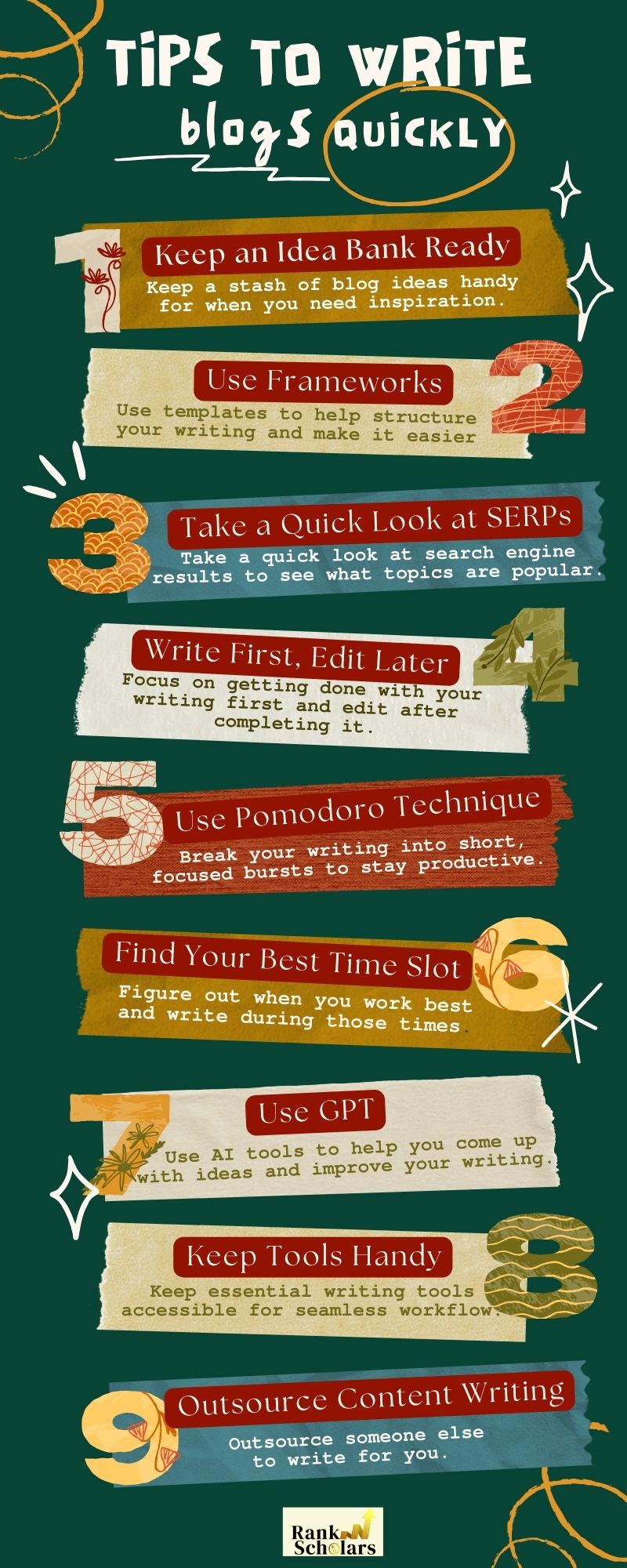Writing a blog post often feels like a huge challenge. With a mountain of tasks, finding the time and energy to craft high quality blog posts takes a lot of work. Recycling from others’ content might seem like a quick shortcut; however, this method causes you to lose originality. This also jeopardizes visibility in the digital world.
Publishing blog posts faster can lead to great visibility among the target audience and eventually, more conversions.
In this blog, we’ve explored 9 practical tips on how to write blog posts faster. By implementing these strategies you can boost your blog writing process and get into that writing flow.

4 Reasons Why It Takes to Write Too Long
When it comes to writing faster, there are certain obstacles that bloggers face. And these are often some deep-rooted mindset issues. With a simple mindset shift you can pave the way to a smoother content creation journey.
Imposter syndrome
Imposter syndrome is when you persistently believe that whatever you do is not good enough and that at any moment the world will catch on. It’s common for writers to self-scrutinize their work and feel like their writing is not standard enough for certain publications or that they are not qualified enough for the role.
Being aware of imposter syndrome, taking more challenges, and recognizing your past accomplishments can help you fight this mindset monster.
Procrastination
Procrastination is the act of voluntarily delaying or postponing something despite knowing its negative consequences. Often writers are afraid of making mistakes or being turned down by publishers and it leads to falling into the trap of the “I’ll do it later” zone.
Identifying the root causes of your procrastination, setting manageable goals & creating a conducive writing environment can help you kick procrastination out and reclaim precious writing time.
Writer’s block
Writer’s block is when a writer is unable to produce new work or experiences a creative slowdown in the writing process. It’s quite common for writers to go through this nightmare. When inspiration dies down, falling into the pit of procrastination becomes an easier path to follow.
However, the approach of waiting for the right mood to start writing is not a good idea when it comes to running a business. To overcome this, instead of waiting for inspiration, keep writing, no matter how imperfect or uninspired the words may seem. You can always refine and polish it later.
Distractions
Writers face a variety of distractions while writing a piece of content. A quick scroll through social media in search of inspiration can easily devolve into hours lost in the abyss of cat videos and memes. Each distraction, no matter how trivial, chips away at the writer’s focus, making it difficult to maintain momentum and achieve writing goals.
Setting boundaries, implementing techniques such as Pomodoro, and using tools & apps designed to minimize distraction can be a helpful approach to overcome this issue.
How to Write Content Faster?
Lately, the fastest way to write content is by using AI tools. You can use AI to brainstorm ideas and outline the structure of your content in a faster way than doing it from scratch. But AI is not 100% accurate when it comes to stats and data, you need to sprinkle your human touch to ensure accuracy.
Use the power of batching similar tasks together to minimize context switching and maximize productivity. Focus on reputable sources to research and use tools like templates and outlines to organize your thoughts efficiently.
Eliminate distractions by creating a work environment and setting a deadline. Keep the art of editing as a separate step and allow your ideas to flow freely during the initial writing phase. And finally, don’t forget to take breaks to recharge and maintain momentum.
9 Tips to Write Blogs Quickly
Below are 9 actionable and practical tips you can look into to write blogs quickly

Keep an Idea Bank Ready
Many content creators struggle with generating fresh ideas regularly. And that’s why having an idea bank swoops in to save the day.
Maintaining an idea bank is like having a treasure of inspiration available at your fingertips. This approach can help you to save time. You can easily pick one topic from your idea bank and start writing instantly instead of searching for content ideas for hours.
Whether it’s a trending industry news piece, bookmarking interesting articles, a reader-suggested topic, or a brainstorming session, your idea bank serves as a lifeline, rescuing you from your writer’s block zone.
Make it a habit to write down ideas as they come to you, whether it’s during your morning coffee or a late night munching. With an idea bank ready, you’ll never be at a loss for what to write about.
Also read: 30 FREE Content Writing Tools For Your Blog
Use Frameworks
A framework is a structured blog post outline or template that provides a systematic approach to organizing and presenting information. According to HubSpot, bloggers who use frameworks such as blog post templates report a 50% increase in writing speed and a 60% improvement in content organization.
The framework acts as a roadmap, guiding writers through the ideation, outline, and drafting with clarity and efficiency.
Using a framework for “Problem-Solution” prompts, writers can identify pain points faced by their audience and present solutions or actionable steps to address these challenges. Similarly, the “Listicle” framework organizes content into digestible lists, making it easier for readers to understand.
Using frameworks tailored according to your niche and content goals, you can streamline the writing process, and produce high-quality blog posts at a faster pace.
Take a Quick Look at SERPs
Taking a quick glance at Search Engine Results Pages (SERPs) can be a game-changer before you start writing your blog. This is because it offers a brief of what’s already out there, and insights such as audience preferences, content gaps, and trending topics to help you tailor your content accordingly.
Shockingly Less than 10% of users pass through the first page of search results, so optimizing your content to rank higher is really vital.
By analyzing SERPs, you can identify popular keywords from keyword research as well as the long tail versions of the keywords, uncover relevant blog topics, and content gaps, and use this information to create content that meets user intent.
For instance, if you’re writing a blog about “healthy breakfast recipes,” a glance at SERPs might reveal that users are particularly interested. Using this knowledge, you can tailor your content to address these specific needs and appeal to your target audience.
Write First, Edit Later
“Write First, Edit Later” is the mantra you must always keep in mind for a swift content creation process. The urge to perfect every sentence as it’s written slows down the writing process significantly and you end up spending more time on a specific part than you assumed.
Writers spend nearly 30% of their time editing during the initial drafting phase, and it leads to frustration and stalled progress. By postponing the editing phase till you complete the first draft, you can maintain momentum and let your creativity flow.
The habit of constant self-editing often makes you become overly critical of your work before allowing ideas to fully develop. Write the draft first and edit it later. One of the best writing tools is Google Docs, use it to write the draft and then switch to the edit tab.
The approach of writing first and editing later encourages a free flowing exchange of ideas, resulting in more authentic and engaging content that resonates with your readers.
Use Pomodoro Technique
The Pomodoro technique is a time management method that maximizes your productivity by allowing you to complete as many tasks on your list.
With this technique, you break your work into manageable intervals, typically 25 minutes of focused writing followed by a short 5-minute break to recharge, followed by the rinse and repeat method. This approach not only boosts productivity but also lessens the overwhelming feeling you get after lengthy writing sessions.
For example, a study by the University of Illinois found that brief breaks between tasks can lead to improved mental agility and reduced fatigue, resulting in higher overall productivity. Imagine tackling your blog post in bite-sized chunks, completing multiple Pomodoros throughout the day.
By implementing this technique, you can easily write your blog faster and achieve your writing goals.
Find Your Best Time Slot
Research indicates that individuals’ capacities to think clearly vary throughout the day, with certain times offering heightened focus and creativity.
By identifying your peak hour time slot for writing, you can maximize your productivity. According to a study by the American Psychological Association, people tend to be most alert and productive during late morning hours, typically between 10 a.m. and 12 p.m. Conversely, the post-lunch slump often sees a dip in mental acuity, making it challenging to tackle complex tasks.
But the peak hours for individuals depend from person to person. If you find ideas early in the morning hours, use the time to tackle your writing projects. Alternatively, if you’re a night owl who thrives in late evenings, embrace the nocturnal period to unleash your creativity.
To maximize your writing efficiency, experiment with different time slots to pinpoint when you feel most alert and focused. With this, you can produce high-quality content with greater ease and efficiency.
Use GPT
Using GPT can be a game changer when it comes to speeding up the writing process. With GPT, you can use the power of artificial intelligence to create content faster. Generating content ideas, outlining structures, and even drafting entire paragraphs becomes easy with the help of GPT.
Remember to cross-check the facts and data because oftentimes the AI-generated stats are not accurate and if you’re publishing content as it is you might lose credibility.
Whether you’re a seasoned writer or an amateur one, GPT offers you multiple ways you can overcome your writing deadline. You can streamline the content creation process, freeing up valuable time for refining and polishing your work.
If you use GPT as your writing assistant, you can conquer the challenge of producing high-quality blog posts in a faster way.
Also read: How To Humanize AI Content (10 Ways + Tools)
Keep Tools Handy
It’s no secret that using writing tools improves the efficiency and overall writing experience. There are several writing tools you can use to save time and elevate the quality of your content, such as:
Grammarly: This tool catches errors and suggests improvements as you type. With over 30 million daily users, it’s the go-to tool for polishing prose and enhancing clarity.
Hemingway Editor: It highlights dense passages, making it easier to spot and streamline convoluted writing. Its readability score provides instant feedback on the accessibility of your content.
Google Docs: Google Docs allows real-time editing and commenting, streamlining the revision process seamlessly.
Copyscape: Copyscape is a plagiarism detection tool that scans content to ensure its originality by comparing it against existing online material.
By keeping these essential writing tools handy, you can boost your writing productivity.
Outsource Content Writing
Often it might be overwhelming to produce high-quality compelling content regularly. That’s when outsourcing comes to your rescue.
With outsourcing, you can assign content writing tasks to professionals or freelance writers resulting in some burden off of your shoulders. With this approach, you can fully focus on other aspects of your business while amazingly written blog articles are already delivered to your inbox.
For example, Rank Scholar, the content marketing agency, outsources freelance writers to create weekly blog posts, freeing up valuable time to focus on client relationships or service improvement.
Similarly, an e-commerce store could partner with a content marketing agency to produce compelling product descriptions and blog content, driving traffic and conversions.
Also Read: How to Use Content Marketing to Grow Your Business in 7 Steps
Final Words
Creating blog posts faster was once an overwhelming task but not anymore. With the tips we’ve discussed in this blog on how to write blog posts faster, now you can write blog posts fast. By using the power of AI tools along with other writing tools and techniques you can create engaging blog posts that captivate audiences and drive results.

Sahanaj is a content writer who is passionate about turning ideas into words that inspire positive change.



